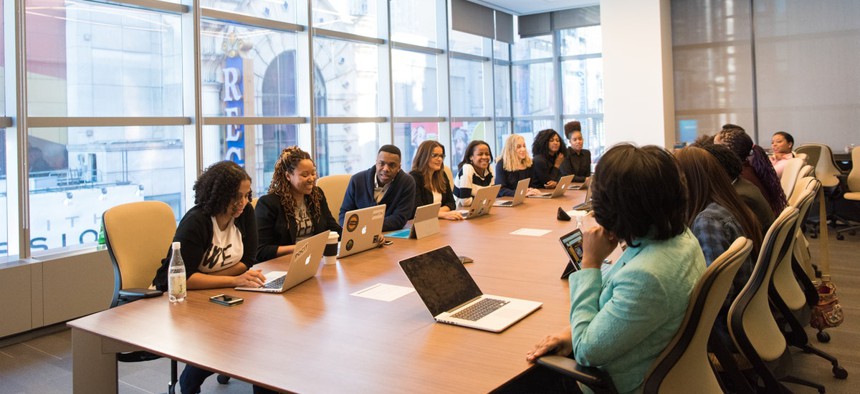Think back to the first day of class in high school. You walked into the classroom and before you were rows of empty desks. Where would you sit? If you choose a seat up front, the teacher would likely see you as a studious pupil, eager to learn and participate in discussions. If you sat in the back, the assumption might have been that you were trying to hide.
As a nonverbal communication researcher, I’ve studied proxemics (the study of how people use space when they’re communicating) in my doctoral dissertation, and while the room may have changed since high school, where and how you sit during a business meeting still has an effect on how you are perceived.
Although most aren’t aware of the dynamics at play, each seat around a conference table serves a specific role and unwittingly says who you are as a professional—at least, psychologically speaking. Where and how you sit can not only influence your role in that meeting, it can increase the likelihood of confrontation or success.
If you are aware, you can use the subtleties of seating to your advantage. You just need to understand the suggestive significance of each seat. Outlined below is your road map.
The power seat
This is the most visible seat in the room; the head of the table, if you will. Situated at the end of the table, facing the door, the person sitting here can see everyone come and go, and he or she can make eye-contact with anyone else at the table — giving him or her the most influence. Typically, this seat is taken by a high-ranking person, such as a manager or C-suite executive. This key position puts you at the center of the discussion, where you can use your unique vantage point to control the conversation. So if you’re seeking to command attention and steer the direction of a meeting, be sure to snag this seat.
The second in command
The seats to the left and right of the power seat represent those who are next in line in the hierarchy of office politics, or those who wish to be. If you’re looking for upward mobility, make a beeline for either of these coveted seats. If you have a choice though, consider this: Research conducted by the University of Oregon has indicated that sitting to the left of a person in the power seat yields far more favor from them, whereas the seat to their right is often viewed as more powerful (you’ve heard the term “right-hand man”…). Whether you want to ingratiate yourself with the person in charge or claim your own authority is up to you.
The focal point
While the power seat is the most visible, the focal point is where that person in power is looking. This is the seat directly opposite the power seat at the other end of the table (with its back to the door). The person sitting here likely feels strongly about a topic and wants to lead the discussion and sway opinions. There’s no better seat to stand out and take control than this one. Proceed with caution though, because this position directly confronts the power seat. You’re making a statement that you are strong competition.
The debater
The seats in-between the key positions at the table should be navigated with careful thought as well. Sitting across from someone can foster a competitive and defensive atmosphere, increasing chances of debate and even hostility, hence the reason opponents “face each other” in competition. Sitting next to someone (especially to the left) helps limit conflict since the position is deemed friendlier and less confrontational. Most people will subconsciously choose to sit next to someone with whom they think alike or work well, but you can use this position strategically as well. If you want to mitigate tension between you and a coworker you’ve been going toe-to-toe with on a project, sit beside them.
But what if your conference table has no end?
Thanks to businesses looking to cultivate an environment that promotes creativity and encourages employees to speak their mind, traditional conference tables are being replaced with everything from oval and round to u-shaped designs.
If your table is arranged in such a way that there is no seat at the end (e.g., a round or u-shaped table), the power seat would be the chair in the middle, facing the door. The rules for second in command hold true, as do those for the debater. However, depending on the table, the focal point may still reside directly opposite the power seat, or may not exist at all—in which case, if you’re looking to lead the discussion, you’ll just have to speak up.
Now that we’ve mapped out where to sit, it’s just as important to pay attention to how you sit. A person’s body language speaks volumes, and you want yours to convey openness, eagerness and loyalty. To do so, it’s as simple as playing the “lava game”. Just like when you were a kid, pretending the floor was molten hot lava that you couldn’t touch, pretend the back half of your chair is hot lava. This will force you to sit towards the front of the chair, giving you two choices: sit up straight with good posture or lean slightly forward. Either way, you’ll look more engaged, which translates to trustworthiness and increases your likability. Conversely, sitting back and/or leaning back or to the side is the same as leaning away psychologically. Just like crossing your arms, these postures place an invisible barrier between you and other people, signifying disinterest.
The next time you go to a meeting, ask yourself what you want to accomplish. With this newfound conference table consciousness, you can sit with confidence knowing that the nuances of seating symbolism are in your favor.
Dustin York is the director of undergraduate and graduate communication at Maryville University.







